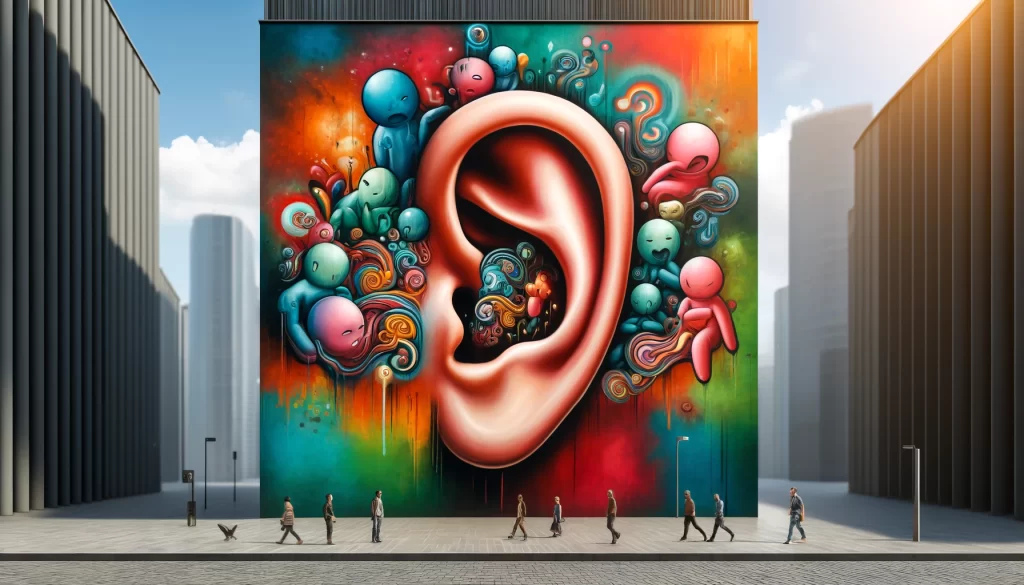Physical Address
304 North Cardinal St.
Dorchester Center, MA 02124

In the midst of life’s hustle and bustle, anxiety treatment often tags along, shadowing the steps of countless individuals. It’s a condition that’s as pervasive as it is personal, demanding our attention and care. Yet, the conversation is shifting from mere coping mechanisms to a transformative dialogue that redefines anxiety treatment.
This evolution in approach opens a gateway to not just manage anxiety, but to harness it as a catalyst for growth. With cutting-edge strategies and an understanding that’s deeper than ever, we’re on the brink of turning the tides—from being at the mercy of anxiety to mastering the art of thriving in spite of it.

Anxiety is not just a fleeting sense of unease; it’s a multifaceted mental health condition that afflicts millions globally. At its core, it’s characterized by an excessive, persistent worry that can interfere with daily activities. It’s crucial, then, to delve deep into the essence of anxiety, to truly grasp its impact on individuals and society at large. Recognizing its significance is the first step towards transformative treatment, a journey from enduring to excelling.
This condition manifests in various forms, from Generalized Anxiety Disorder (GAD) to panic attacks, social anxiety, and specific phobias. Each type brings its unique challenges, yet they all share a common thread—a persistent sense of apprehension that can be crippling. It’s this commonality that draws attention to the importance of effective treatment strategies, signaling a shift from simply managing symptoms to understanding and addressing the root causes of anxiety.
The repercussions of untreated anxiety stretch far and wide. Beyond the mental strain, it can lead to physical symptoms like insomnia, digestive issues, and a weakened immune system. The interplay between mind and body in anxiety is a stark reminder that our approach to treatment must be holistic and nuanced, acknowledging the full spectrum of symptoms and their ripple effects on health.
Moreover, the societal implications of widespread anxiety are profound. From decreased productivity to strained healthcare systems, the tentacles of anxiety can reach into the very fabric of society, affecting economic stability and community well-being. It’s a matter of public health, economic interest, and, most importantly, personal quality of life.
Acknowledging the gravity of anxiety is therefore not just about individual well-being—it’s about nurturing resilient communities. With this awareness, we pivot towards a transformative model of anxiety treatment that aims not just to alleviate, but to empower. By reorienting our perspective from surviving to thriving, we set the stage for a future where anxiety no longer defines limits but strengthens the narrative of personal triumph.

Identifying anxiety is akin to understanding a complex language; it speaks through a variety of symptoms, both psychological and physiological. The mental symptoms often manifest as incessant worries that spiral beyond control, plaguing the mind with what-ifs and worst-case scenarios. Recognizing these signs is vital, for they are the early whispers of anxiety that, if heeded, can lead to proactive treatment.
Physical manifestations of anxiety are often the body’s alarm system, signaling distress through rapid heartbeat, sweating, trembling, and fatigue. These symptoms can become so pronounced that they disrupt day-to-day life, masquerading as other health issues and often leading to a cascade of medical evaluations. Learning to interpret these signals accurately is a cornerstone in the identification of anxiety.
The subtler signs, such as irritability, restlessness, and difficulty concentrating, are sometimes overshadowed by the more overt symptoms. Yet, they are equally telling. They hint at an underlying current of anxiety that may not yet have reached the surface. Recognizing these subtler signs requires a mindful awareness of one’s mental state and behaviors.
Anxiety also weaves its way into the social fabric of life, presenting as avoidance of social situations or a withdrawal from activities once enjoyed. It’s in these changes to one’s social patterns that clues to anxiety can often be found. A keen observation of these shifts is crucial for early detection and treatment.
Prompt identification of anxiety is a lifeline to effective management. It’s the first step on the transformative journey from a life overshadowed by anxiety to one where each individual not only copes but thrives. With each sign recognized, the path to overcoming anxiety becomes clearer, guiding toward a future where thriving is the new norm.

Innovative approaches to anxiety treatment have emerged, shifting the paradigm and offering new avenues for relief and transformation. Cognitive-behavioral therapy (CBT) remains a cornerstone, renowned for its effectiveness. It challenges and changes unhelpful cognitive distortions and behaviors, improves emotional regulation, and develops personal coping strategies that target solving current problems. CBT’s adaptability to individual needs makes it a powerful ally in the quest to thrive beyond anxiety.
Mindfulness and meditation have also gained traction, spotlighting the power of presence. By anchoring one’s attention to the here and now, mindfulness practices teach individuals to observe their thoughts without judgment, reducing the impact of anxiety-provoking stimuli. This practice cultivates a mental space where calm can take root, allowing individuals to respond to anxiety with intention rather than react in fear.
Virtual Reality Exposure Therapy (VRET) has emerged as a cutting-edge tool, especially for specific phobias and social anxiety. By simulating real-life scenarios in a controlled, virtual environment, VRET safely exposes individuals to their fears, progressively desensitizing and reducing anxiety responses. This innovative method represents the merging of technology and psychology, broadening the scope of what’s possible in anxiety treatment.
Equally transformative are the advances in pharmacotherapy, where medication can provide a much-needed respite for those with severe anxiety. When combined with therapy, medications can offer a dual approach, managing the physiological aspects while the psychological roots are addressed, forming a comprehensive treatment plan.
As we embrace these innovative treatments, the potential for a full life transformation becomes tangible. It’s a movement from a reality constricted by anxiety to one where individuals are equipped with the tools to not only manage their condition but to excel in spite of it.

Lifestyle changes can serve as a robust complement to formal anxiety treatment, establishing a foundation for long-term wellbeing. Exercise, for instance, is more than a physical activity; it’s a powerful stimulant for mental health. Engaging in regular physical exercise releases endorphins, often dubbed ‘feel-good hormones,’ which can naturally elevate mood and reduce stress levels. By incorporating a consistent exercise regimen, individuals can build resilience against anxiety.
Nutrition plays an equally critical role in managing anxiety. What we fuel our bodies with has a direct correlation to our mental state. Diets rich in whole foods like vegetables, fruits, and whole grains provide essential nutrients that support brain health, while the reduction of stimulants such as caffeine and sugar can decrease anxiety symptoms. Eating balanced meals at regular intervals stabilizes blood sugar levels, thereby mitigating mood swings and irritability associated with anxiety.
Sleep, the cornerstone of recovery, is profoundly linked with anxiety. A lack of quality sleep can exacerbate anxious feelings, creating a vicious cycle. Establishing a soothing bedtime routine and creating a restful environment can significantly improve sleep quality. Prioritizing sleep is prioritizing mental health, allowing the body and mind to heal and rejuvenate.
Mindfulness practices extend beyond meditation; they encompass daily activities done with intention and attention. Simple acts of mindfulness can create a sense of calm and control throughout the day, further fortifying the mind against the onslaught of anxiety.
Finally, establishing a routine that incorporates these lifestyle elements can provide a sense of control and predictability, which is often lost in the chaos of anxiety. It’s through these daily, intentional actions that individuals find strength, slowly transforming from surviving anxiety to thriving in life.

A robust support system is often the unsung hero in the narrative of overcoming anxiety. It provides a platform of reassurance and understanding, essential for those navigating the tumultuous waters of an anxiety disorder. Friends, family, and peers can offer comfort and advice, forming a network of care that surrounds the individual with a sense of safety and belonging.
Professional support, such as therapists and counselors, plays a critical role, offering not just expert guidance but also validation of the individual’s experiences. Their expertise in navigating the complexities of anxiety can be a beacon of hope, illuminating the path to wellness with strategies and insights tailored to each person’s unique journey.
Support groups, whether in-person or online, offer a community of empathy and shared experiences. Here, individuals can exchange personal stories, coping strategies, and encouragement. This collective wisdom can be a powerful force, normalizing the struggles and triumphs that come with anxiety treatment.
Peer support extends the reach of traditional therapy, providing a daily touchstone for individuals. It’s in the shared laughter, understanding nods, and mutual encouragement that the everyday reality of living with anxiety becomes more manageable. These peer connections can blossom into enduring friendships that reinforce the individual’s progress and motivation.
The significance of a support system in anxiety treatment cannot be understated. It creates a web of interpersonal connections that can catch an individual when they fall and help them to rise again. It is within this nurturing environment that surviving can shift to thriving, with each supportive interaction weaving strength into the journey of overcoming anxiety.

Acceptance plays a pivotal role in the journey of overcoming anxiety, acting as a transformative element in the treatment process. It begins with the understanding that anxiety is not a flaw or a weakness but a part of the human condition. This acceptance helps dismantle the stigma around mental health, allowing individuals to approach their situation without shame or guilt.
The power of acceptance lies in its ability to change the individual’s relationship with anxiety. Rather than engaging in a constant battle against their feelings, individuals learn to recognize and acknowledge their anxiety without judgment. This shift in perspective can significantly reduce the intensity of anxiety, as it removes the additional stress of trying to ‘fight’ the condition.
By embracing acceptance, individuals can focus on managing their anxiety more effectively. It allows them to observe their feelings and thoughts from a distance, gaining insight into what triggers their anxiety and how it manifests. This mindful observation is crucial for developing effective coping strategies that work in real-time situations.
Moreover, acceptance facilitates a more compassionate self-dialogue, which is essential for healing. Self-compassion fosters resilience, enabling individuals to face their fears and challenges with kindness and understanding, rather than self-criticism and doubt.
Ultimately, the practice of acceptance encourages a holistic approach to anxiety treatment. It promotes an environment where individuals are not only managing their symptoms but also growing and learning from their experiences. This holistic approach not only alleviates anxiety but also enriches the person’s overall life, leading to lasting personal development and well-being.

Thriving after anxiety treatment requires a commitment to long-term strategies that ensure sustained progress and prevent relapse. Key among these strategies is the continued practice of skills learned during therapy. Techniques such as cognitive restructuring, mindfulness, and exposure practices should be integrated into daily routines, allowing individuals to maintain their gains and continue improving their mental health.
Regular self-assessment is another vital component of long-term success. Individuals should periodically evaluate their anxiety levels and emotional well-being to identify any emerging patterns or triggers. This ongoing monitoring helps catch potential setbacks early and adjust coping strategies accordingly, ensuring that therapy gains are not only maintained but built upon.
Another crucial strategy is maintaining a growth mindset, which involves viewing challenges as opportunities for growth rather than threats. This perspective encourages resilience and adaptability, key traits for anyone looking to thrive after anxiety treatment. It fosters a proactive approach to mental health, where continuous learning and development are prioritized.
Engaging in a supportive community can also provide ongoing encouragement and insight. Whether it’s through therapy groups, online forums, or local meetups, staying connected with others who understand the journey can reinforce personal progress and provide motivation during challenging times.
Lastly, it’s important to celebrate successes, no matter how small. Recognizing and rewarding oneself for overcoming hurdles reinforces positive behavior and boosts morale. Celebrations can serve as reminders of how far one has come and the strength they possess, which is invaluable for anyone on the path from surviving anxiety to thriving in life.

The journey from surviving to thriving with anxiety is not a straight path but a series of meaningful steps that reshape how we understand and interact with our mental health. Embracing both traditional and innovative treatments, supported by lifestyle adjustments and a solid support network, creates a comprehensive strategy that not only addresses the symptoms but also the root causes of anxiety.
By adopting a proactive and informed approach to anxiety treatment, individuals can transform their lives, achieving not just recovery but a state of flourishing and resilience. For more details, visit our website.




